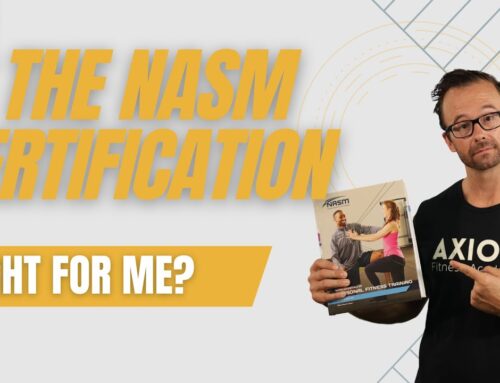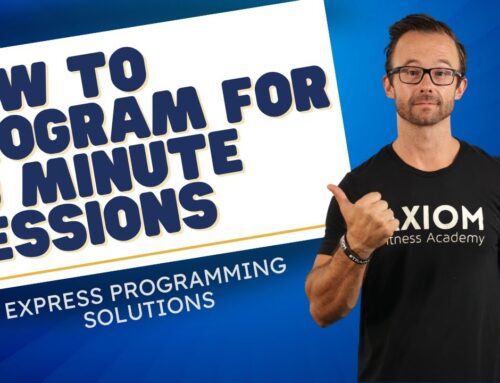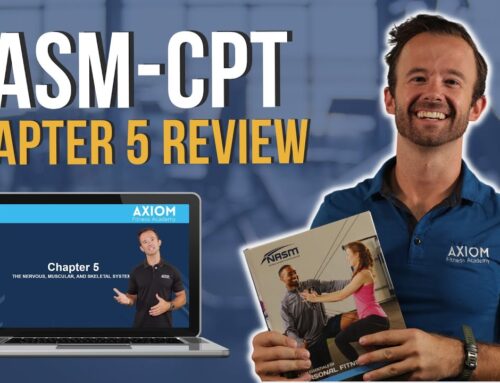
Welcome to our in-depth guide where we address some of the most frequently asked questions about the National Academy of Sports Medicine (NASM) Certified Personal Trainer (CPT) exam. This post is designed to demystify the NASM exam process, clarify common misconceptions, and prepare you for what truly lies ahead on your journey to becoming a NASM-CPT. Whether you’re just starting out or are nearing your exam date, this guide, inspired by insights from Coach Joe Drake, CEO and founder of Axiom Fitness Academy, will set the record straight and get you ready to ace your NASM exam.
Dispelling the Myth: The Structure of the NASM-CPT Exam
A question from Taymah Hewitt inside our NASM Personal Trainer Facebook group brought to light a common misunderstanding: the belief that the NASM cycles through four to five different types of exams. This is a crucial point of confusion, and Taymah, you’re not alone in this. Many aspiring trainers are navigating through a sea of information, and sometimes misinformation, about the NASM-CPT exam.
Here’s the truth: there’s only one type of NASM-CPT exam. While it might seem like there are different versions floating around, especially when listening to various test-takers’ experiences, each exam is unique not in type but in the version of questions presented. This variety in question versions often leads to the misconception of entirely different exams.
Understanding the Exam Structure
The NASM exam is meticulously structured to ensure every candidate is tested equally, adhering to a specific percentage breakdown across six sections. These sections correspond with the NASM study material chapters, ensuring a comprehensive assessment of your knowledge. Here’s a breakdown:
- Section 1 & 2: Focuses on the foundational chapters 1-4.
- Section 3: Dives into the science-heavy chapters 5-10, a section that often intimidates candidates.
- Sections 4 to 6: Cover assessments, training strategies, and programming knowledge from chapters 11 onwards.
Each section contributes a set number of questions to the exam, ensuring a balanced representation of the material. For instance, expect to see a certain number of questions specifically from chapters 1 and 2, and so on. This structured randomness ensures every test-taker receives a unique but equally challenging exam.
Common NASM-CPT Exam Questions Answered
Now that we’ve cleared up the main misconception about the exam’s structure let’s tackle some other common questions.
Are there practical or visual questions?
Many wonder if the exam includes practical demonstrations or visual identifications. The straightforward answer is no. The NASM-CPT exam consists entirely of multiple-choice questions, eliminating the need for practical demonstrations or identifying muscles in pictures. While you’ll need to apply practical knowledge to answer scenario-based questions, the format remains multiple-choice.
Will I need to perform calculations?
Another area of concern involves calculations, particularly around formulas and programming. Rest assured, no calculators are required (or allowed), and the exam will not heavily focus on calculation-intensive questions. Any calculations you may encounter are designed to be straightforward, enabling educated guesses without detailed computations.
Do I find out which questions I got wrong?
Upon completing the exam, many are eager to learn which specific questions they missed. While the intention behind this curiosity is admirable, NASM does not disclose which questions were answered incorrectly. Instead, candidates receive their overall score, providing a general sense of performance. This policy maintains the integrity of the exam and ensures its ongoing fairness and confidentiality.
Key Takeaways for NASM-CPT Aspirants
As you prepare for your NASM-CPT exam, remember:
- One exam type, many question versions: Understand the structure is consistent, but the questions vary.
- Focus on the big picture: Concentrate on grasping the core concepts across all chapters rather than memorizing specifics.
- Prepare for a multiple-choice format: Develop a strong foundation in the material to confidently tackle scenario-based questions.
- Aim for comprehension, not calculation: Don’t get bogged down by the fear of complex math problems.
- Learn from the experience: Use the exam as an opportunity to solidify your knowledge and prepare for a successful career in personal training.
Armed with this information, we hope you feel more prepared and less anxious about what to expect from the NASM-CPT exam. Remember, the journey to becoming a certified personal trainer is a marathon, not a sprint. By understanding the exam structure, focusing on your study material, and approaching your preparation with a positive mindset, you’re already on the path to success.
In this video, Axiom Fitness Academy instructor Joe Drake shares his expert advice on exactly what to expect while taking your Exam.






